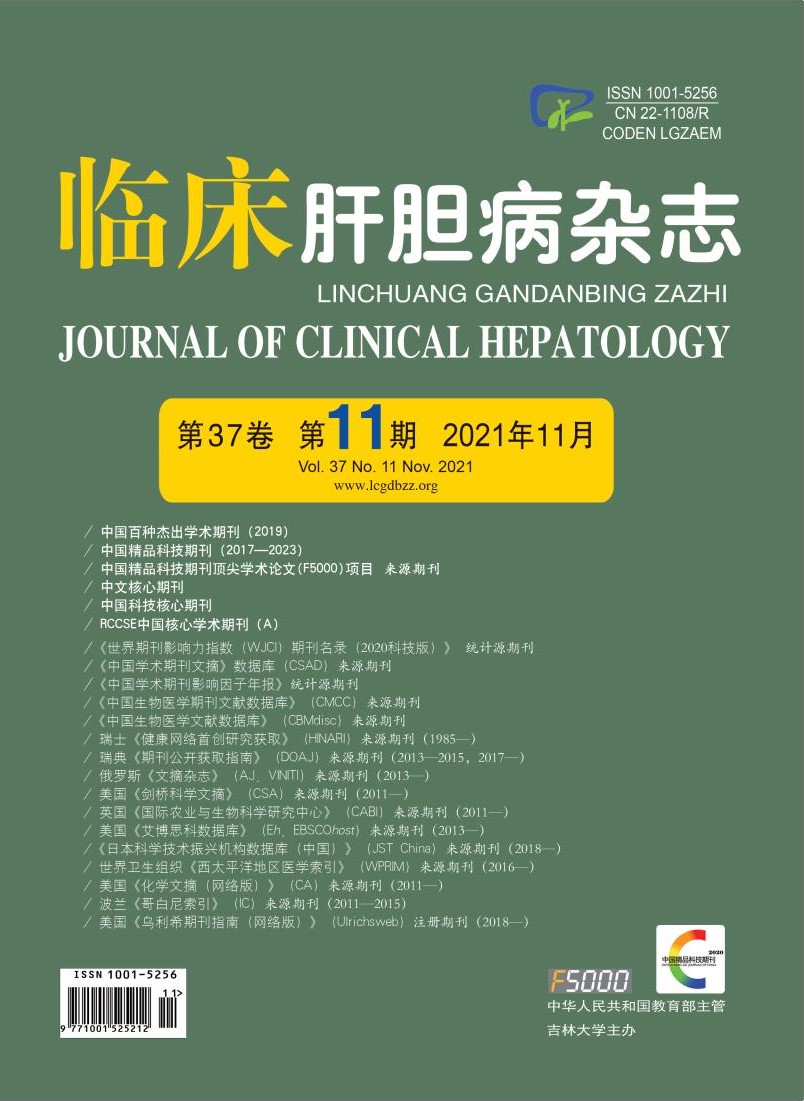| [1] |
YOUNOSSI ZM, KOENIG AB, ABDELATIF D, et al. Global epidemiology of nonalcoholic fatty liver disease-Meta-analytic assessment of prevalence, incidence, and outcomes[J]. Hepatology, 2016, 64(1): 73-84. DOI: 10.1002/hep.28431. |
| [2] |
WANG XJ, MALHI H. Nonalcoholic fatty liver disease[J]. Ann Intern Med, 2018, 169(9): ITC65-65ITC80. DOI: 10.7326/AITC201811060. |
| [3] |
TOMIC D, KEMP WW, ROBERTS SK. Nonalcoholic fatty liver disease: Current concepts, epidemiology and management strategies[J]. Eur J Gastroenterol Hepatol, 2018, 30(10): 1103-1115. DOI: 10.1097/MEG.0000000000001235. |
| [4] |
National Workshop on Fatty Liver and Alcoholic Liver Disease, Chinese Society of Hepatology, Chinese Medical Association, Fatty Liver Expert Committee, Chinese Medical Doctor Association. Guidelines of prevention and treatment for nonalcoholic fatty liver disease: A 2018 update[J]. J Clin Hepatol, 2018, 34(5): 947-957. DOI: 10.3969/j.issn.1001-5256.2018.05.007. |
| [5] |
KWOK R, CHOI KC, WONG GL, et al. Screening diabetic patients for non-alcoholic fatty liver disease with controlled attenuation parameter and liver stiffness measurements: A prospective cohort study[J]. Gut, 2016, 65(8): 1359-1368. DOI: 10.1136/gutjnl-2015-309265. |
| [6] |
GBD 2019 Risk Factors Collaborators. Global burden of 87 risk factors in 204 countries and territories, 1990-2019: A systematic analysis for the Global Burden of Disease Study 2019[J]. Lancet, 2020, 396(10258): 1223-1249. DOI: 10.1016/S0140-6736(20)30752-2. |
| [7] |
LI Z, XUE J, CHEN P, et al. Prevalence of nonalcoholic fatty liver disease in mainland of China: A meta-analysis of published studies[J]. J Gastroenterol Hepatol, 2014, 29(1): 42-51. DOI: 10.1111/jgh.12428. |
| [8] |
LIN S, XIAN Y, LIU Y, et al. Risk factors and community intervention for nonalcoholic fatty liver disease in community residents of Urumqi, China[J]. Medicine (Baltimore), 2018, 97(9): e0021. DOI: 10.1097/MD.0000000000010021. |
| [9] |
WANG L, WU GL, GE L. Investigation of fatty liver in health examination of residents in Kuytun area[J]. Bull Dis Control Prev(CHINA), 2018, 33(2): 54-55, 58. DOI: 10.13215/j.cnki.jbyfkztb.1712001. |
| [10] |
YE Q, ZOU B, YEO YH, et al. Global prevalence, incidence, and outcomes of non-obese or lean non-alcoholic fatty liver disease: A systematic review and meta-analysis[J]. Lancet Gastroenterol Hepatol, 2020, 5(8): 739-752. DOI: 10.1016/S2468-1253(20)30077-7. |
| [11] |
CHEN HT, ZHOU YJ. Diagnosis and therapeutic strategies for non-obese type of non-alcoholic fatty liver diseases[J]. Chin J Hepatol, 2020, 28(3): 203-207. DOI: 10.3760/cma.j.cn501113-20191226-00480. |
| [12] |
HA Y, SEO N, SHIM JH, et al. Intimate association of visceral obesity with non-alcoholic fatty liver disease in healthy Asians: A case-control study[J]. J Gastroenterol Hepatol, 2015, 30(11): 1666-1672. DOI: 10.1111/jgh.12996. |
| [13] |
TIAN T, HU WW, LI X, et al. Metabolic characteristics of nonalcoholic fatty liver disease and related risk factors in non-obese population[J]. J Clin Hepatol, 2020, 36(6): 1310-1313. DOI: 10.3969/j.issn.1001-5256.2020.6.024.
|
| [14] |
COTTER TG, RINELLA M. Nonalcoholic fatty liver disease 2020: The state of the disease[J]. Gastroenterology, 2020, 158(7): 1851-1864. DOI: 10.1053/j.gastro.2020.01.052. |
| [15] |
YOUNOSSI Z, ANSTEE QM, MARIETTI M, et al. Global burden of NAFLD and NASH: Trends, predictions, risk factors and prevention[J]. Nat Rev Gastroenterol Hepatol, 2018, 15(1): 11-20. DOI: 10.1038/s41575-020-00381-6. |
| [16] |
ARNER P, BERNARD S, APPELSVED L, et al. Adipose lipid turnover and long-term changes in body weight[J]. Nat Med, 2019, 25(9): 1385-1389. DOI: 10.1038/s41591-019-0565-5. |
| [17] |
PALMISANO BT, ZHU L, ECKEL RH, et al. Sex differences in lipid and lipoprotein metabolism[J]. Mol Metab, 2018, 15: 45-55. DOI: 10.1016/j.molmet.2018.05.008. |
| [18] |
|
| [19] |
VENETSANAKI V, POLYZOS SA. Menopause and non-alcoholic fatty liver disease: A review focusing on therapeutic perspectives[J]. Curr Vasc Pharmacol, 2019, 17(6): 546-555. DOI: 10.2174/1570161116666180711121949. |
| [20] |
LI YY, XIE ZY. Advances in the etiology and treatment of non-obese nonalcoholic fatty liver disease[J]. J Clin Hepatol, 2021, 37(2): 452-457. DOI: 10.3969/j.issn.1001-5256.2021.02.043. |
| [21] |
|







 DownLoad:
DownLoad: